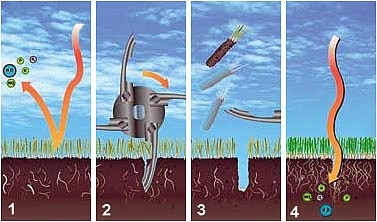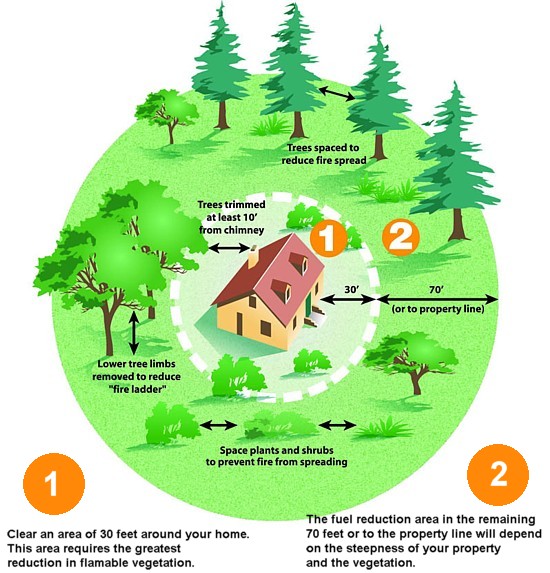
Aeration is the process of mechanically removing cores of turf to improve the flow of air, water and nutrients in dense, compacted soil. Soil compaction, caused by lawn traffic such as walking and moving, is one of the greatest causes of turf deterioration. When soil is compacted, dirt particles are forced together, reducing the area where roots can grow. Aeration relieves soil compaction by improving the exchange of water and critical nutrients to grass roots.

Should I water before aerating?
Best aerating condition is a soft and moist ground. If you are unsure of the ground conditions, as in soil with high clay content, a simple test will determine whether it is necessary to water before aerating. Using a garden hand spade or a large screw driver, you should be able to drive the tool in the ground 2 to 3 inches with little effort. If you are unable to do so, then watering the lawn a day before aerating is necessary.
What type of Fence should I choose?
Along with functionality, fencing should be pleasing in style and should compliment your home. For example, if the home is a modernistic style, the best fencing selections would include sleek lines of iron and aluminum. Ranch-style homes might consider split rail fencing and rugged wooden posts while traditional homes tend to remain with wooden picket and privacy fencing. Whatever the selection, the key is to remain open to design and consider the style of the home rather than your personal preference. A fencing selection should be pleasing to the eye.
For assistance with your fencing selection contact us for design recommendations and pricing and visit our photo galleries for Privacy Fencing and See Through Fencing
Practicing good defensible space is an important part of being a property owner in Lake Tahoe. US Forest Service records show that over the last 35 years over 150 fires burned in or within a two-mile radius of North Lake Tahoe. One of the goals of the forestry department is to help property owners bring their properties into compliance with state, local and association fire safety standards. Work completed by individual property owners is key to keeping all of us safe from wildfire.

Topdressing consists of applying a layer of soil, sand, compost, or a mixture thereof to turf grass. Top dressing is applied in layers ranging from 1/16 – 1/2 inch at a time, generally once every growing season. Lawns require topdressing to maintain a uniform surface, which is helpful for drainage. Often times, these materials act as a soil amendment as well and are a practical method for leveling out dips and ruts. Other benefits of top dressing include:
Are lawns a good idea in Tahoe?
Lawns offer many advantages in a high altitude arid environment. They add beauty and value, help cool your home in summer, add a natural fire break, control dust and if properly installed and maintained, use water in a highly efficient manner. How efficiently? Recent scientific studies have shown that lawns use less water than commonly used shrubs and trees!
Can Voles hurt my landscaping?
As the snow continues to melt and reveal our lawns, we can see the damage the voles have done. They have been very busy this winter under the snow, chewing on our lawns, perennials and even some trees and shrubs! Voles are little, hardy field mice that live in their underground tunnels and homes in your yard. They can create havoc in your yard, but tend to find other food supplies on the perimeter during the summer, especially if you take a little action. Voles can be very destructive. This rodent resembles a house mouse, only with a short tail and small ears. Colored brown to gray, voles have a lighter colored belly, an easy difference from mice. Voles grow 4 to 6 inches long. Large incisor top teeth are what distinguish this rodent from a mole. Voles eat vegetation, feeding on roots, bulbs and anything they can find. They cause a lot of destruction by gnawing on young trees and shrubs. They can strip the bark of the plant at ground level, killing or exposing it to insects or diseases. One way to tell if you have voles is to locate runways in the lawn. These 2 inch wide strips meander throughout the lawn at the surface. These strips usually end at a hole, going into an abandoned mole hole. Nicely rounded holes in your yard indicate you have both moles and voles. Voles have a tremendous reproductive rate, able to give birth at one month of age. Voles have several litters a year, sometimes seeming to take over. This rodent can be especially destructive in Christmas tree farms and fruit orchards. Moles and voles are difficult to eliminate once they have become established. Chemical controls can be used, but it is advisable to use a professional. Call us today for a quote
I've always heard that fall is for planting. Why is that so?
In the fall, plant material goes dormant. When this happens, there is less risk of transplant shock for your plants, and less demanding watering requirements for you.
Is salting driveways and walkways bad for nearby plants and some paving surfaces?
While deicing agents such as salt and calcium chloride are effective at melting the snow and ice, they can also harm some plant material. It's best to keep the use of salt and calcium chloride products to a minimum, and to remove them from your driveways and walkways as soon as the surfaces are clear and dry. If you do use a deicer, spread the smallest amount necessary to begin breaking up the hardened chunks of ice, then get in there with your shovel and some elbow grease. Besides your plants, many driveway and walkway surfaces do not hold up well to excessive salting or deicing, especially those made from concrete. And don't forget that on softer paving surfaces, such as brick, concrete pavers and flagstone, you should stick with a plastic snow shovel. Metal shovels can chip and damage the material lying just below the ice and snow.
Do I need to shut my pond down for the winter? How will my fish survive if I do?
It may not be necessarily to shut down your pond for the winter. But, if you do decide to leave it running, keep an eye out for ice dams that can form on the waterfalls. These dams can cause leaks. Clear out leaves and debris as they build up in the pond, too. Since fish hibernate at the bottom of ponds for the winter, they should survive just fine. Just be sure the pond doesn't completely freeze down to the bottom. In the late, chilly part of fall, you can even stop feeding your fish, since they won't digest food properly in the cold water anyway.
When is it too late to plant or do landscape construction in our area?
You can plant and landscape through much of the fall, up until the ground freezes.
Do I need to be concerned about watering my plants in the months before winter?
Yes! Plants still need water all the way through autumn-especially newly planted trees and shrubs. This fall, make sure your plants get all the water they require, just as you did during the warmer months. (If drought restrictions are still in effect in your area, be sure your watering habits meet these requirements.)